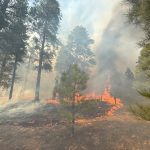
Guest Column | Navajo Nation, take action now to stop new uranium mining
By Tommy Rock
Editor’s note: Dr. Rock is from Oljato, Utah.
Please allow me to introduce myself in the way my grandparents taught me. My name is Tommy Rock. I am Áshįįhí (Salt clan), born for the Tł’ízíłání (Many Goats Clan). My maternal clan is the Tódích’íi’nii (Bitter Water Clan), and my paternal clan is the Lók’aa Dine’é (Reed People Clan).
I am from Oljato Chapter. I have earned a Ph.D. from NAU in earth science and environmental sustainability. I am currently working in Princeton, New Jersey, as a Princeton University presidential post-doctoral research fellow in the Department of Geoscience.
As we Diné know all too well, the uranium mining and milling that occurred in the Navajo Nation left a sad legacy. Many community members within the affected regions of our reservation have tragic stories about losing relatives to illnesses directly resulting from prolonged radiation and radon exposure.
In November 2006, Judy Pasternak, a reporter for the Los Angeles Times, wrote a series of three articles on the subject of Navajo abandoned uranium mines. Honorable Henry A. Waxman (D-Calif.) was in the U.S. House of Representatives at the time, representing a district in the Los Angeles area. He read her articles and was appalled.
As a result, he did more than any Arizona, New Mexico, or Utah representative or senator has been willing to do for the Navajo Nation regarding uranium. As chair of the House Oversight Committee from 2007-09 and chair of the House Energy Committee from 2009-11, he brought federal agency leaders before both committees and grilled them.
In so many words, he told several agencies that they needed to work together to clean up the mess that the federal government had made. He was distraught that the federal government had not acted to clean up the mines for decades. Rep. Waxman did not stop at one hearing; instead, he held several and kept checking in on the work through additional questioning, even though he changed committees.
Since 2015, Rep. Waxman is no longer in Congress, and no one is willing to put the agency’s feet to the fire as effectively as he did. As a result, I have seen the same PowerPoint presentation from the United States Environmental Protection Agency since 2007. The only thing that changed was the person doing the presentation. Don’t get me started on how exhausted our people have become in making numerous emotionally exhausted testimonies before the U.S. EPA and the Nuclear Regulatory Commission, to no effect.
The federal agencies claim 524 abandoned uranium mines in the Navajo Nation. There are more than 1,100 abandoned uranium mines and mine features. Not only has it been a constant fight to get the federal government to act on cleanup, but it has also been a feat to get them to complete it satisfactorily.
This waste will remain radioactive for hundreds to thousands of years. Who knows what challenges we will face in getting the federal government to act when the time comes for the upkeep of these waste containment sites? This waste will affect us five-fingered beings far beyond the seven generations.
Research teams from the University of New Mexico (DiNEH Project and Navajo Birth Cohort Study) have gathered data to support and affirm the link between uranium exposure and adverse health conditions. The federal government understood that the miners and millers would not experience immediate effects. They relied on the fact that prolonged exposure would result in illness that would not show up for many decades later to avoid liability and ensure their continued access to uranium.
We are in a different position than we were when the federal government and its contractors took advantage of us as early as 1942. Today, we have the awareness, data, and experience to know that uranium mining transforms our living environment into a slow killer.
In 2005, the Navajo Nation Council passed the Diné Natural Resources and Protection Act, and former President Shirley signed it into law. In 2012, the Radioactive and Related Substance Equipment, Vehicle, Persons and Materials Transportation Act set forth procedures to be followed by these mining companies when they set foot in Navajo Indian Country.
Despite everything I have written here, an outside company recently showed up, unannounced, at a site in Church Rock Chapter and started drilling for uranium on a location that’s been drilled repeatedly since the early 1960s. The company not only didn’t inform the community but apparently didn’t ask the Navajo Nation for permission to enter the Old Church Rock Mine (OCRM) site, the surface of which is Tribal Trust Land.
The company reportedly told tribal officials that it has a right to drill to reach its mineral estate. Once the Navajo Nation learned about this intrusion onto our land – alerted by grassroots groups keeping tabs on the drilling operation at OCRM – it did nothing to stop it.
Whether drilling on Navajo Trust land, fee simple land, or federal land, mining companies have no right to be drilling in Navajo Indian Country. This company conflicts with the Navajo Nation ban on uranium mining, which applies to any uranium mining and processing “in Navajo Indian Country” (18 N.N.C §1303).
Where are our leaders and lawyers? Why was this allowed to happen? If this can occur today, what is to prevent other Navajo communities from being similarly vulnerable? I call on the Nygren Administration to take whatever legal and legislative steps to stop a new era of uranium mining on Diné Bikéyah.








 Highway 264,
Highway 264, I-40, WB @ Winslow
I-40, WB @ Winslow